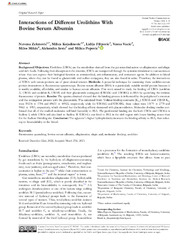Приказ основних података о документу
Interactions of Different Urolithins With Bovine Serum Albumin
| dc.creator | Zelenović, Nevena | |
| dc.creator | Kojadinovic, Milica | |
| dc.creator | Filipović, Lidija | |
| dc.creator | Vucic, Vesna | |
| dc.creator | Milčić, Miloš | |
| dc.creator | Arsić, Aleksndra | |
| dc.creator | Popović, Milica | |
| dc.date.accessioned | 2023-12-27T16:22:49Z | |
| dc.date.available | 2023-12-27T16:22:49Z | |
| dc.date.issued | 2023 | |
| dc.identifier.issn | 1934-578X | |
| dc.identifier.issn | 1555-9475 | |
| dc.identifier.uri | https://cer.ihtm.bg.ac.rs/handle/123456789/7223 | |
| dc.description.abstract | Backgound/Objectives Urolithins (UROs) are the metabolites derived from the gut microbial action on ellagitannins and ellagic acid-rich foods. Following their absorption in the intestine, UROs are transported through the systemic circulation to various tissues where they can express their biological function as antimicrobial, anti-inflammatory, and anticancer agents. In addition to blood plasma, where they can be found as glucuronide and sulfate conjugates, they are also found in urine. Therefore, the interactions of UROs with serum proteins are of great clinical interest. Methods A powerful technique for examining these urolithin-serum protein interactions is fluorescence spectroscopy. Bovine serum albumin (BSA) is a particularly suitable model protein because it is readily available, affordable, and similar to human serum albumin. This work aimed to study the binding of UROs (urolithin A, UROA and urolithin B, UROB) and their glucuronide conjugates (UROAG and UROBG) to BSA by quenching the intrinsic fluorescence of protein. Results The spectra obtained showed that the binding process is influenced by the polyphenol's structure and the conjugation process with the glucuronide. The calculated Stern Vollmer binding constants (Ksv): UROA and UROB Ksv were 59236 ± 5706 and 69653 ± 14922, respectively, while for UROAG and UROBG, these values were 15179 ± 2770 and 9462 ± 1955, respectively, which showed that the binding affinity decreased with glucuronidation. Molecular docking studies confirmed that all of the studied molecules will bind favorably to BSA. The preferential binding site for both UROs and UROGs is Sudlow I, while UROs will also bind to Sudlow II. URO-Gs can bind to BSA in the cleft region with lower binding scores than for the Sudlow I binding site. Conclusion The aglycone's higher hydrophobicity increases the binding affinity to BSA, thus reducing its bioavailability in the blood. | |
| dc.publisher | SAGE Publications | en |
| dc.relation | info:eu-repo/grantAgreement/MESTD/inst-2020/200288/RS//istarstvo Prosvete, Nauke i Tehnološkog Razvoja https://doi.org/10.13039/501100004564 : 451-03-9/2021-14/200288 | en |
| dc.relation | info:eu-repo/grantAgreement/MESTD/inst-2020/200015/RS// | en |
| dc.relation | info:eu-repo/grantAgreement/MESTD/inst-2020/200026/RS// | en |
| dc.rights | openAccess | |
| dc.rights.uri | https://creativecommons.org/licenses/by-nc/4.0/ | |
| dc.source | Natural Product Communications | en |
| dc.subject | fluorescence quenching | |
| dc.subject | bovine serum albumin | |
| dc.subject | ellagitannins | |
| dc.subject | elagic acid | |
| dc.subject | molecular docking | |
| dc.subject | urolithin | |
| dc.title | Interactions of Different Urolithins With Bovine Serum Albumin | en |
| dc.type | article | en |
| dc.rights.license | BY-NC | |
| dc.citation.volume | 18 | |
| dc.citation.issue | 5 | |
| dc.citation.spage | 1934578X2311693 | |
| dc.citation.rank | M23~ | |
| dc.identifier.doi | 10.1177/1934578X231169366 | |
| dc.identifier.fulltext | http://cer.ihtm.bg.ac.rs/bitstream/id/28964/zelenovic-et-al-2023-interactions-of-different-urolithins-with-bovine-serum-albumin.pdf | |
| dc.identifier.scopus | 2-s2.0-85158914449 | |
| dc.type.version | publishedVersion |


